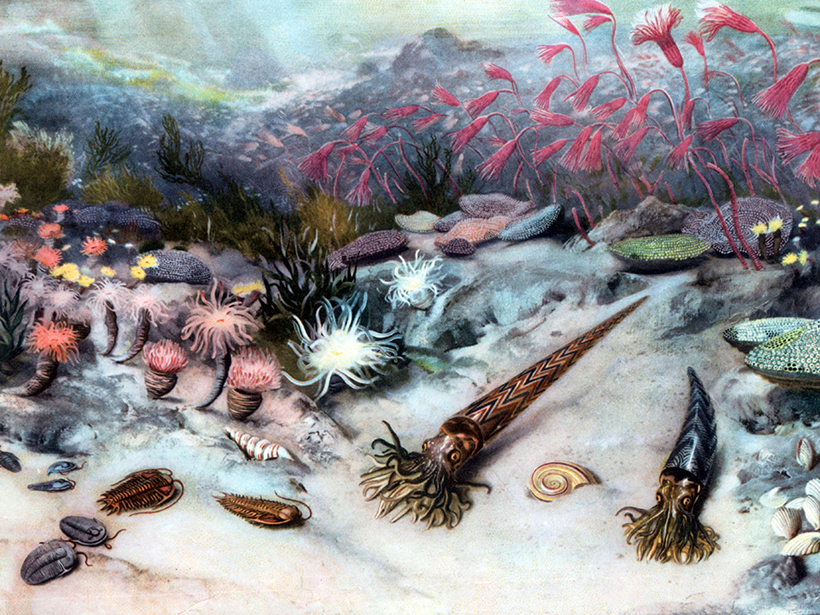More than three quarters of all marine life died about half a billion years ago. At least, that’s what the rocks say.
Below a certain depth in the stratigraphic record, trilobites, corals, and brachiopods thrived in the ocean. Above it, many types of these organisms are missing. What could have caused 85% of marine species—at a time when life largely existed only in the oceans—to just up and perish?
New research offers an unlikely linchpin in this vast die-off: tiny algae. Around the time of this extinction event, algae populations were rising ocean-wide. When these abundant organisms lived, they soaked up atmospheric carbon and stored it in their tissues. But when they died, they may have sunk quickly through the water column, scientists have proposed, rapidly sequestering carbon in the depths of the ocean as more and more such organisms lived and died.
The new study “reveals how algal evolution could have been vital in regulating the Earth’s carbon cycle.”
The planet then cooled as a result of having less carbon dioxide in the atmosphere, plausibly triggering the widespread glaciation that’s believed to have prompted one of the Earth’s largest mass extinction events, the new work suggests. The research was published last month in Nature Geoscience.
The new study “reveals how algal evolution could have been vital in regulating the Earth’s carbon cycle,” said Richard Pancost, a biogeochemist at the University of Bristol in the United Kingdom not involved in the research. “It is a fascinating hypothesis based on some exciting new data.”
Ocean Sediments in Nevada
The key to this hypothesis lies in ancient ocean sediments unearthed from Nevada dating to the very end of the Ordovician period, roughly 444 million years ago. Jiaheng Shen, lead author of the paper and a geochemist at Harvard University, and her colleagues collected samples of these sediments—mostly shale and limestone—and found that they contained compounds derived from chlorophyll.
Analysis showed that the ratios of isotopes of nitrogen in these compounds matched those found in modern-day algae. Thus, the researchers proposed that the presence of these compounds meant that they were created by ancient algae, which died and sank to the seafloor to create the sediments.
As the researchers analyzed samples from younger rocks, they found a trend: The sediments appeared to contain more and more material from algae. Over a period of just a few million years, the amount of the telltale compounds increased by approximately fivefold, the team estimated. The measurements implied that algae must have flourished during the Late Ordovician at the expense of other phytoplankton like cyanobacteria.
Size Matters
Did this population shift, perhaps in response to an increase in nutrients released by weathering or volcanism, result in carbon being sequestered deep in the ocean? The answer, the authors pose, rests on a key factor: the relative sizes of algae and cyanobacteria. Most types of modern algae are several times larger than cyanobacteria.
If the algae were at least twice as large as their cyanobacterial counterparts, the population shift could have triggered rapid cooling.
If the algae that rose to prominence were at least twice as large as their cyanobacterial counterparts, the population shift could have triggered rapid cooling, explained Ann Pearson, an environmental scientist at Harvard University and one of the study’s coauthors. That’s because according to particle settling rates described by Stokes’s law, more massive algae sink more rapidly through water than smaller, lighter cyanobacteria. Because of those different sinking rates, carbon would have been pulled into the deep ocean nearly 4 times faster than it was when cyanobacteria dominated the oceans, the researchers estimated.
The team wasn’t able to precisely calculate how much larger the ancient algae were compared with cyanobacteria, however. “We cannot say directly what the sizes were, only how much relative change would have been sufficient to make a difference,” Pearson told Eos.
Rapid Cooling
The team used a model of nutrient cycling to calculate that atmospheric carbon dioxide levels would have been cut in half.
The hypothesized rapid carbon sequestration would have, in turn, rapidly pulled carbon from the ocean-atmosphere system and trapped it on the seafloor. If the hypothesis is correct, this rapid sequestration would have had important repercussions for Earth’s carbon cycle and therefore the planet’s temperature.
The team used a model of nutrient cycling in the ocean and atmosphere to calculate that atmospheric carbon dioxide levels would have been cut in half. This decrease, in turn, would have caused rapid cooling of several degrees Celsius over just a few million years, which may have prompted the Late Ordovician glaciation.
Algae may therefore have been the time period’s “indirect killers,” the authors wrote in their paper. That’s a powerful statement, explained coauthor Greg Henkes, a geochemist at Stony Brook University in Stony Brook, N.Y., and a coauthor of the paper. “Seemingly benign effects, such as primary producer size and organic carbon burial, can magnify [over] geologic intervals of time,” he said.
—Katherine Kornei (email: [email protected]; @katherinekornei), Freelance Science Journalist
Citation:
Kornei, K. (2018), Tiny algae may have prompted a mass extinction, Eos, 99, https://doi.org/10.1029/2018EO102539. Published on 11 July 2018.
Text © 2018. The authors. CC BY-NC-ND 3.0
Except where otherwise noted, images are subject to copyright. Any reuse without express permission from the copyright owner is prohibited.

